After two thrilling nights of Champions League football, our attention was turned towards the Europa League. The competition also made its comeback with many interesting clashes that involved some of the big names. In Germany, Marco Rose’s Borussia Mönchengladbach welcomed the Austrian club Wolfsberger A.C. to their home, Borussia-Park.
Rose is very familiar with the visitors, having played them when he managed Red Bull Salzburg two seasons earlier. This summer, he was appointed into Mönchengladbach’s managerial spot, replacing Dieter Hecking. They had a big summer that saw many interesting additions coming to the club, such as Ramy Bensebaini, Stefan Lainer and Breel Embolo. And it’s no surprise to see the German club had a positive start to the season, securing seven out of the possible twelve points from the first four matches.
On the other hand, this is Wolfsberger’s second season in the Europa League since 2015. Gerhard Struber’s side finished third in the Austrian Bundesliga and therefore secured their spot in the group stage for the first time in their history. As many would have thought they were an underdog and inexperienced side when they travelled to Germany, things went a different way on the field. They came out on top with a shocking 4-0 win, with three of their goals being scored inside the first half.
This tactical analysis will provide an analysis of Wolfsberger’s dominant win over Borussia Mönchengladbach. Meanwhile, using statistics, we will point out what went wrong in Rose’s tactics against Struber’s tactics.
Lineups
The home side lined up in Rose’s favourite 4-1-2-1-2 formation with Yann Sommer starting in goal. Rose didn’t have the service of Lars Stindl and Jonas Hoffmann due to injuries. Instead, he chose youngster Florian Neuhaus and new signing Marcus Thuram to fill in their respective positions. American defender Fabian Johnson remained on the sideline and he was replaced by another new signing in Ramy Bensebaini.
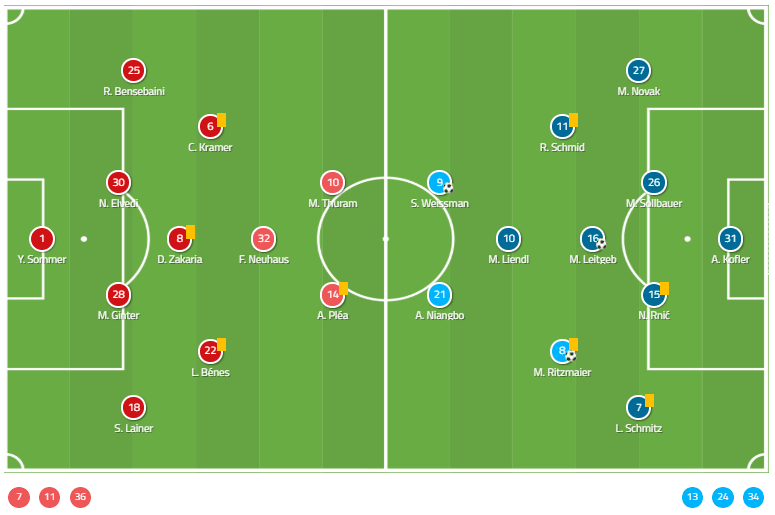
Travelling to Germany with his strongest side, Strauner had a wealth of options to pick for his 4-3-1-2 lineup. Former PSV midfielder Marcel Ritzmaier completed the midfield along with Werder Bremen loanee Romano Schmid and ex-1860 München midfielder Michael Liendl. There was another familiar face for German football fans, especially Düsseldorf fans, as Lukas Schmitz was chosen to be Wolfsberger’s starting left-back.
Mönchengladbach’s style of play
As expected from a side who is managed by Rose, Mönchengladbach immediately put an emphasis on building from the back after the whistle was blown. They held and recycled possession quite efficiently using a four-man build-up that was positioned high up the pitch. In Matthias Ginter and Nico Elvedi, Rose had two natural ball-playing defenders who were comfortable with the ball at their feet.
Meanwhile, two wing-backs also stayed deep in the majority of occasions to provide passing options for the ball carrier. Also, it’s worth noticing that both Lainer and Bensebaini usually moved into the wide-area and stretched the team’s passing block. This allowed them to occupy both flanks and ready to create an attack whenever they received the ball.
Besides from the involvement of the four defenders, one central midfielder, usually Denis Zakaria or Christoph Kramer had the tendency of dropping deep. They were positioned just in front of the two centre-backs to link the defenders with the midfielders up front. At the same time, they would help his teammates in winning the numerical superiority over Wolfsberger’s press. It allowed them to circulate the ball with ease and found solutions or directions to progress the ball up the pitch.
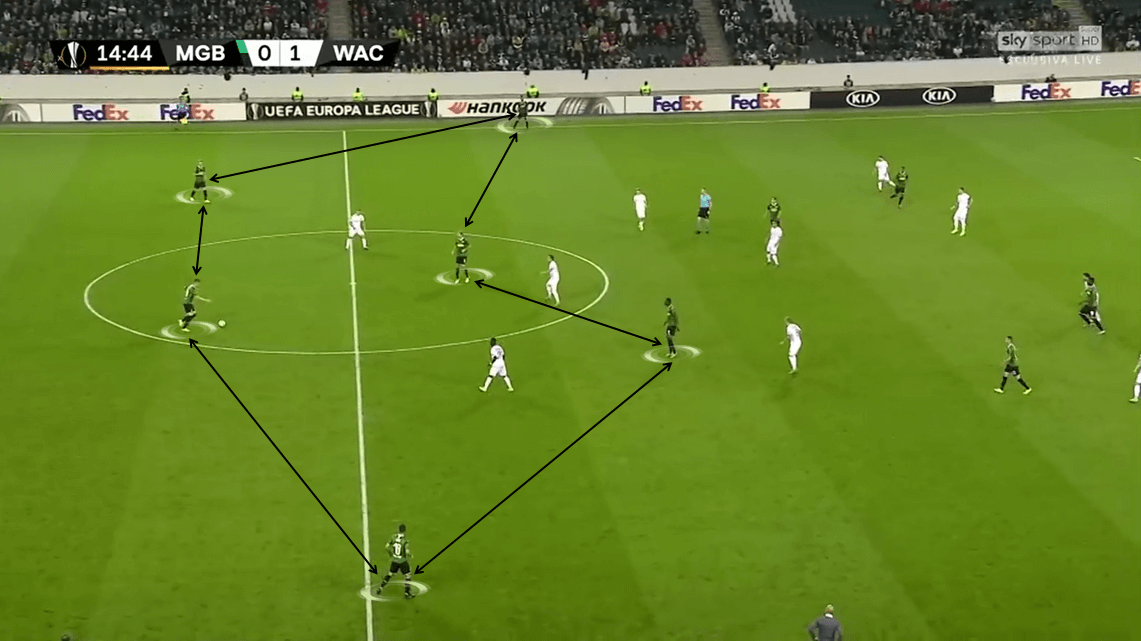
Depending on the situation and how high Wolfsberger pressed, goalkeeper Sommer could also be involved in the build-up. From goal-kicks, he connected the two centre-backs together by acting as an intermediate in between them and received the ball only to lay it to the other centre-back later on.
By keeping at least four players during the build-up process, they were able to bypass Wolfsberger’s press through short combinations. At Salzburg, this is one of the noticeable tactical points that the Austrian champion constantly showed under Rose. The players were confident to hold possession and found ways to bypass the pressure from the opponent. A similar thing was seen among Mönchengladbach’s players as they didn’t show signs of hesitation when they played out from the back.
Furthermore, they used quick passes and combinations during the transitioning process to get the ball into the final third. The players were required to position themselves in pockets of space where they could receive the ball from their teammates. As for the ball carrier, his responsibilities were to bring the ball out of defence and laid it off towards a player who was ready to continue the ball progressing process.
This strategy not only allowed the players to make low-risk passes towards each other but also encouraged them to increase their tempo of play. With most of his teammates located in between Wolfsberger’s defensive lines, Mönchengladbach were able to create strings of connection to quickly get the ball into the final third.
Also, the home side were wing-oriented in most of the time as they wanted to capitalise on the threat that came from Bensebaini and Lainer’s pace. When they distributed the ball wide, the wing-back would receive it while attempting to find teammates who sat on the shoulders of defenders.
In that case, they would send an early, low cross into the box for that player to approach the goal. But unfortunately, that plan was picked out by Wolfsberger’s defenders. Although the likes of Michael Sollbauer and Nemanja Rnić had a late start compared to Mönchengladbach’s striker, those centre-backs usually predicted the ball’s direction and intercepted it with a sliding tackle.
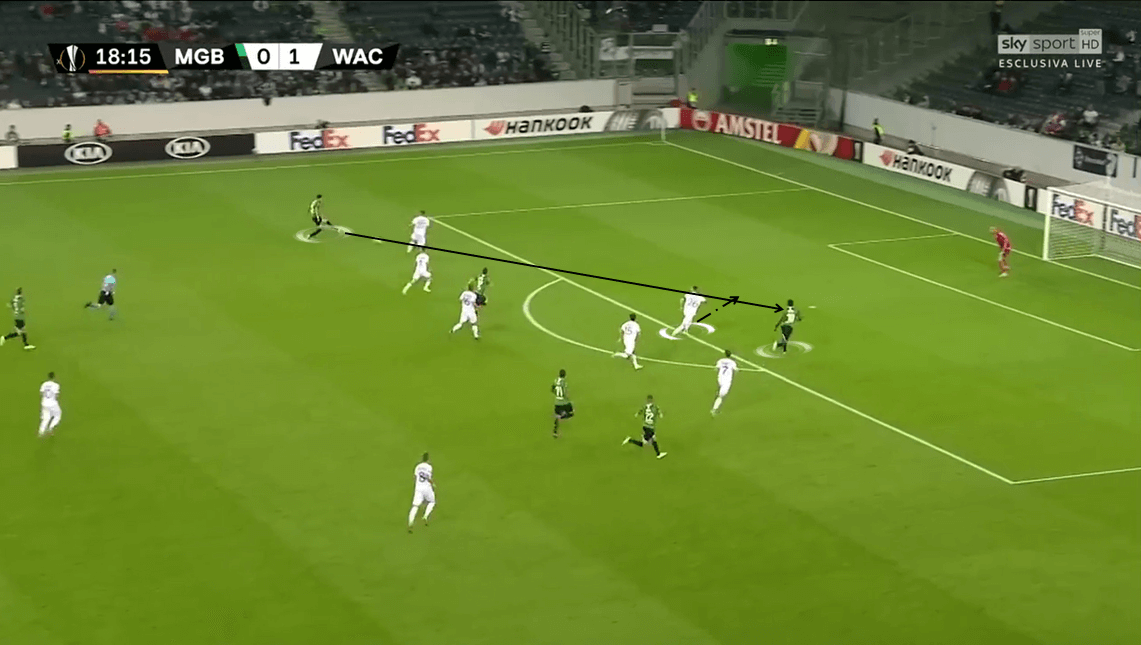
The home side also didn’t have much luck in front of goal as they registered only five of their 15 shots on target. But there was one noticeable point about Mönchengladbach’s chances in this game. While the majority of it were rated below 0.1 xG, they had four chances that reached higher than 0.2. Three of them found the target but luck wasn’t on their side when Alassane Pléa and Ginter couldn’t beat Alexander Kofler in their 1v1 and header situations respectively.
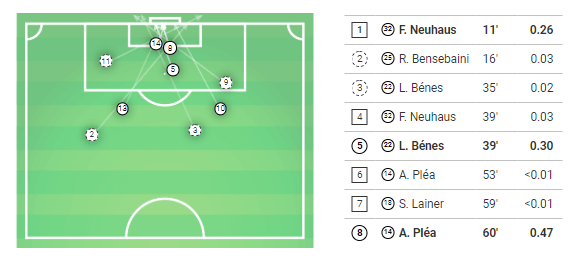
When not in possession, Mönchengladbach formed a clear 4-3-1-2 defensive shape inside their half. The midfielders created a diamond block and attempted to occupy the central area. They would intercept through balls and passes that came towards them for a possible counter-attack. Along with the strikers, at least two midfielders also pushed up to join the press with the aim to disrupt Wolfsberger’s build-up.
But their narrow formation would leave both flanks unoccupied and encouraged the visitors to distribute the ball wide. To deal with this problem, Rose instructed the wing-backs to push higher up the pitch and joined the press along with the midfielders. Lainer was more active with this instruction as the former Salzburg defender roamed from his position to put pressure on the ball carrier who moved into his wing. At the same time, Bensebaini tucked inside and created a back-three that stretched wide to fill in space in front of the box.
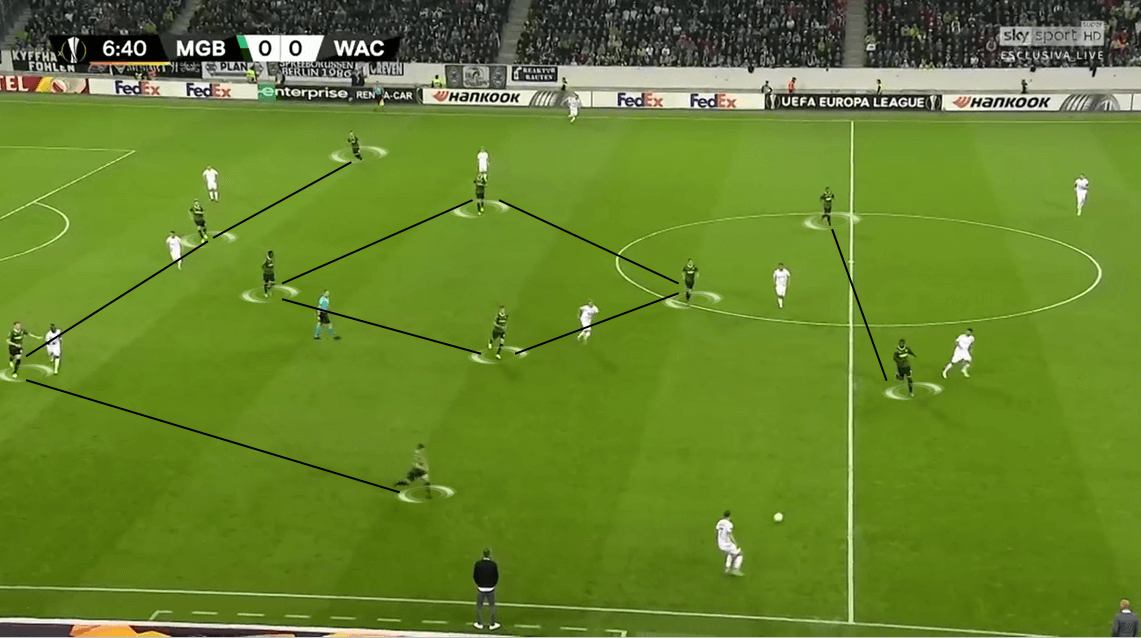
They also had another strategy to prevent Wolfsberger from attacking down both flanks. As the ball carrier moved the ball into the wide areas, the outside central midfielders in Kramer and László Bénes acted as a focal point for the whole shape to shift laterally across the pitch.
This allowed them to create an overload that surrounded the ball carrier and applied pressure on him to recover possession. When his teammates came short to offer passing options, the overload would also cover them by expanding itself and let those players enter the area.
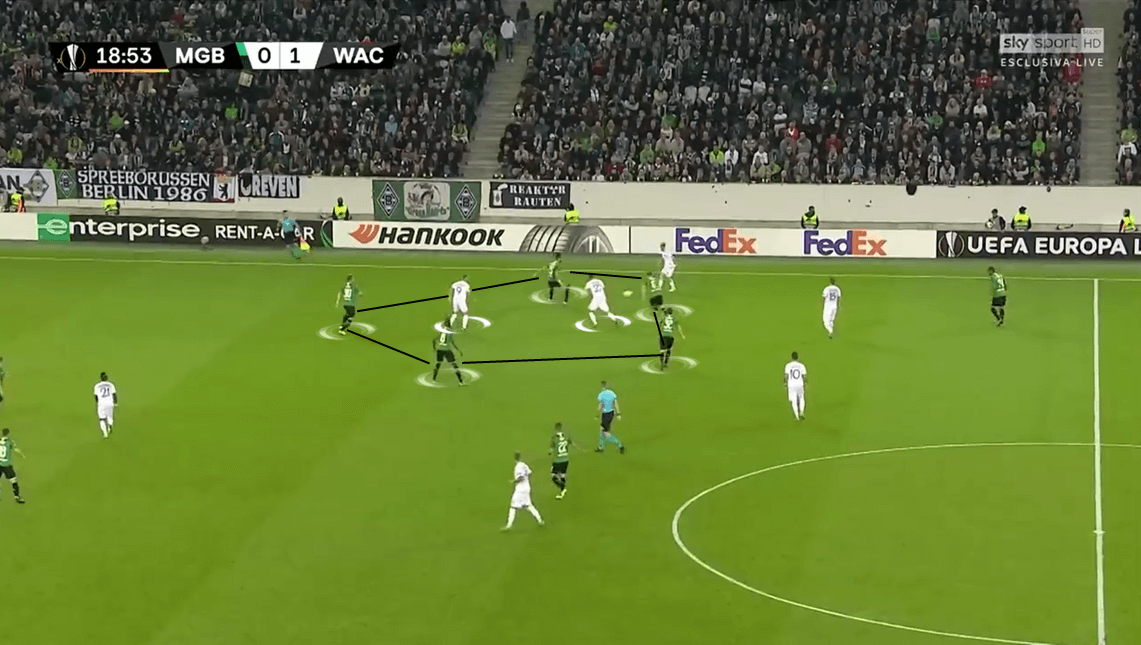
Wolfsberger’s style of play
It seems like the away side overperformed their expected numbers by scoring four goals in the process. In their total of twelve chances, they had seven on target with the accuracy rate of 58%. Furthermore, Wolfsberger had a fair few chances rated over 0.1 and contributed to their total xG rating of 1.39.

Ritzmaier’s goal in the 41st minute was a perfect example for their attacking method throughout the match and how they defined the numbers. From a situation where Liendl capitalised the heavy touch from Bénes, the Austrian midfielder dribbled the ball up the pitch and found striker Anderson Niangbo. There, the Côte d’Ivoire player noticed Ritzmaier was continuing his run into the space behind Mönchengladbach’s defensive line and laid the ball perfectly to him.
While both Bénes and Elvedi attempted to close down his shooting range, Ritzmaier was still able to drive his shot towards the goal. His first attempted was saved by Sommer, but a delicate first-touch allowed him to convert the rebound into Wolfsberger’s third goal of the game.
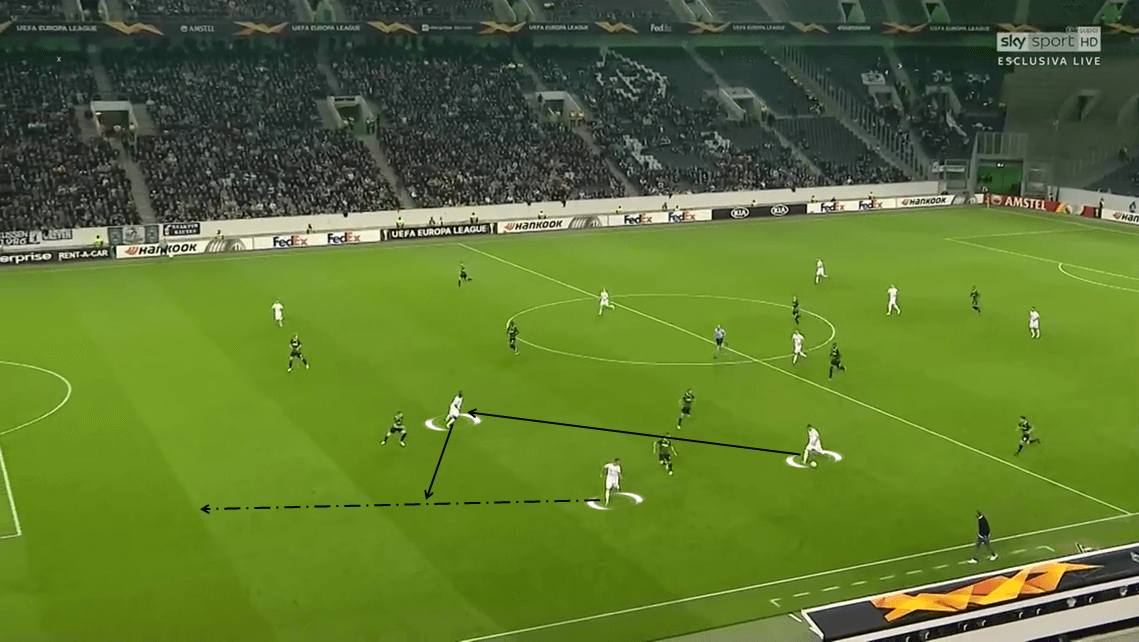
As mentioned, Ritzmaier’s goal demonstrated Wolfsberger’s main attacking method during the match. They constantly used short passes with a high tempo to link the team’s play and build their attacks. Against a stubborn defensive line of the home side, this strategy had proven its efficiency as it allowed them to threaten Sommer’s goal from a close range, specifically inside the box. It is also one of the reasons that contributed to the fact that they had an overwhelming number of seven shots on goal.
Besides from being a threat in open play through their dynamic and fast style of play, they also made the most out of their set-pieces. In fact, two of their goals from Mario Leitgeb and Shon Weissman came from a corner and a free-kick respectively. The common problem that the home side encountered in these two situations was marking the opponent.
Take Leitgeb’s goal as an example. While most of Mönchengladbach players already swarmed the near post and marked the opponent’s players, Bensebaini was tasked to follow Leitgeb to track his run. As the Austrian midfielder moved towards the far post and picked up the ball, Bensebaini lost his concentration on Leitgeb which he capitalised to lose his marker. He was in a free state to identify the ball’s direction and headed the ball for Wolfsberger’s decisive goal of the game.
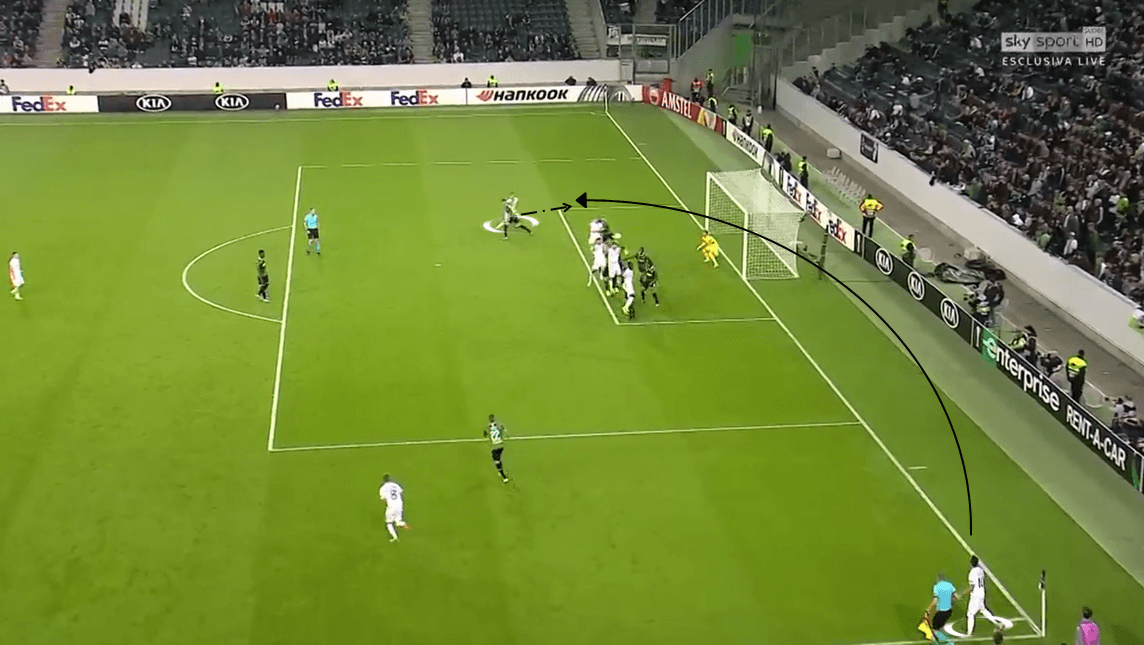
Off the ball, the Austrian side defended in a 4-3-3 formation with Niangbo led the line and Weissman dropped deep alongside Liendl. The strikers’ line had the responsibility of disrupting the opposition’s build-up and recovered possession inside the opposition half. During the first few minutes of the game, they adopted an aggressive attitude when it came to tackle the ball. As this strategy required them to commit many tactical fouls to win the ball back, Wolfsberger players lowered their pressing urgency to stay away from receiving harsh disciplines.
During their pressing process, three attacking players also received support from three central midfielders below. They pushed up to follow the runs of Zakaria and Kramer and prevented them from driving up the pitch along with the ball. At the same time, these players must also combine with the defensive line to cover up gaps in between and behind the lines.
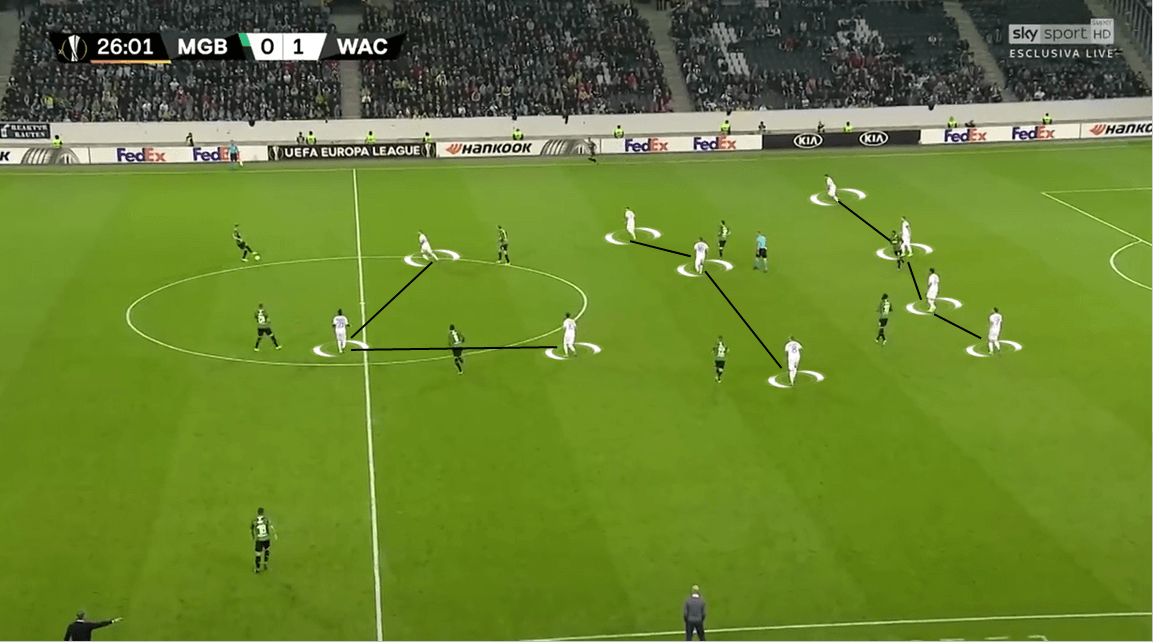
Wolfsberger players had the tendency of remaining stubborn inside zone 14 and in front of the box. This hindered Mönchengladbach’s attacking threat throughout the match and forced them to use long shots to approach Kofler’s goal. Another point that also stood out in how the visitors defended was they used quick turnovers to retreat into their half.
Since most of their players took a part in the team’s attack, they must roam from their respective positions to provide support for the ball carrier. This would leave only two centre-backs behind in case the German side created a counter-attack and they could be able to create a dangerous chance. But with their turnovers strategy along with a high defensive line, the wing-backs and the midfielders were able to join up with Sollbauer and Rnić to defend against the opposition’s attack.
Conclusion
It’s fair to say that no one was expected this result to happen, even the most positive person would only think of a narrow win for Wolfsberger. Instead, the Austrian side secured a dominant 4-0 win over a more highly-rated side in Mönchengladbach. But their result wasn’t based mostly on luck, as they also showed their ability during periods and they capitalised those moments to score the decisive goals.
Wolfsberger will return to Austria with high confidence among their squad after this terrific win and aim to cause an upset in this season’s Europa League. Meanwhile, for Marco Rose and his side, they need a rethink and a detailed analysis of the problems that they encountered in this match. The German club also had times where they controlled the game and executed what they intended, but there are still problems that are waiting to be fixed before their match against Fortuna Düsseldorf this weekend for Rose, his assistant Rene Marić and the team.

If you love tactical analysis, then you’ll love the digital magazines from totalfootballanalysis.com – a guaranteed 100+ pages of pure tactical analysis covering topics from the Premier League, Serie A, La Liga, Bundesliga and many, many more. Buy your copy of the August issue for just ₤4.99 here

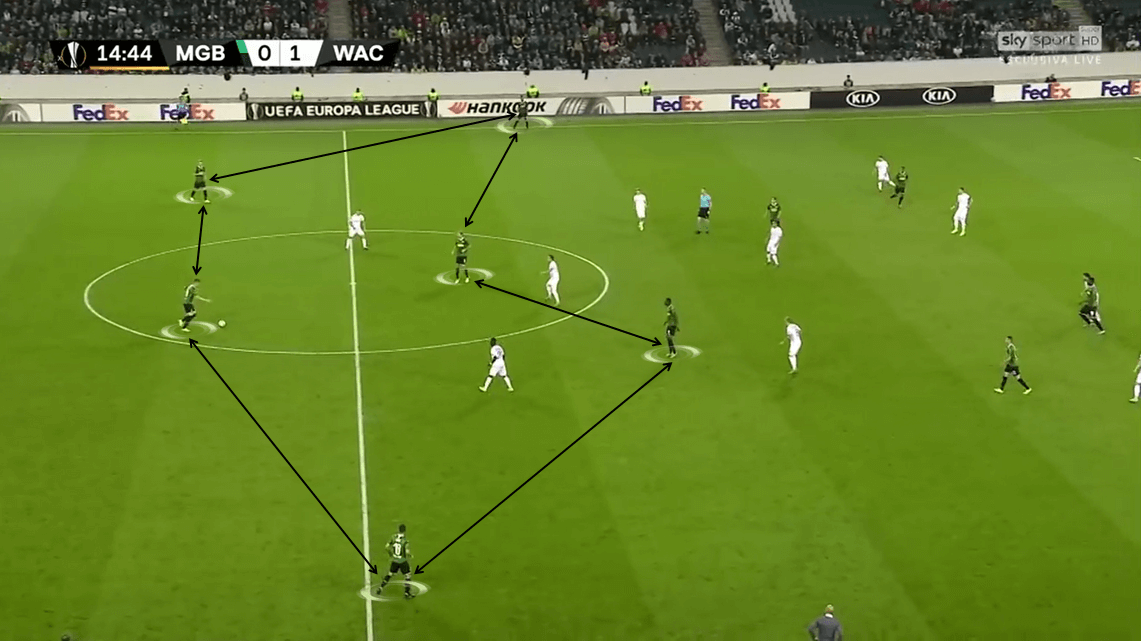



Comments